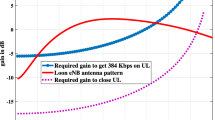Abstract
A new broadband telecommunication system has been recently proposed for provision of fixed, mobile and personal services adopting the use of high altitude platform stations placed in a fixed position in the stratospheric layer at heights from 15.5 to 30 km. The International Telecommunication Union (ITU) has allocated a pair of 300 MHz of spectrum in the V band for these services, which is already in use by geostationary satellite and wireless terrestrial systems as co-primary allocations. This paper addresses an in-depth co-channel interference analysis and proposes a C/I (carrier-to-interference) calculation model applicable to all the interference propagation paths as well as sharing criteria between HAPN, GEO satellite and wireless terrestrial systems extracted from simulations performed in urban, suburban and rural environments. By evaluating the interference density cumulative probability distribution functions, sufficient geographical separation distances between the ground stations are proposed which guarantee the harmonic co-existence between the three broadband systems. Maintaining the platform stable in the stratosphere is a key issue, and in this paper the effect of the three different stratospheric platform’s movement models (ITU, HELINET, HALO) appearing in the literature, on C/I levels is estimated.
Similar content being viewed by others
References
R. Steele, “Communications After AD 2000”, Mobile Communications in the 21st Century, Chapman Hall, New York, 1993.
G.M. Djuknic, J. Freidenfelds and Y. Okunev, “Establishing Wireless Communications Services via High-Altitude Aeronautical Platforms: A Concept Whose Time Has Come?”, IEEE Communications Magazine, pp. 128–135, September 1997.
ITU-R F. 1569, “Technical and Operational Characteristics for the Fixed Service Using High Altitude Platform Stations in the Bands 27.5–28.35 GHz and 31–31.3 GHz”.
R. Miura and M. Suzuki, “Preliminary Flight Test Program on Telecom and Broadcasting Using High Altitude Platform Stations”, Wireless Personal Communications Journal, pp. 341–361, 2003.
N. Colella, J. Martin, and I. Akyildiz, “The HALO Network”, IEEE Communications Magazine, Vol. 38, pp. 141–148, 2000.
B. El-Jabu and R. Steele, “Cellular Communications Using Aerial Platforms”, IEEE Transactions on Vehicular Technology, Vol. 50, pp. 686–700, May 2001.
ITU-R Recommendation F.1500, “Preferred Characteristics of Systems in the Fixed Service Using High Altitude Platforms Operating in the Bands 47.2–47.5 GHz and 47.9–48.2 GHz”.
J. Thorton, D. Grace, C. Spillard, T. Konefal, and T. Tozer, “Broadband Communications from a High-Altitude Platform: The European Helinet programme”, IEE Electronics & Communications Engineering Journal, pp. 138–144, June 2001.
E. Falletti, M. Mondin, and F. Dovis, “Integration of a HAP Within a Terrestrial UMTS Network: Interference Analysis and Cell Dimensioning”, Wireless Personal Communications Journal, pp. 291–325, 2003.
M. Oodo, R. Miura, T. Hori, T. Morisaki, K. Kashiki, and M. Suzuki, “Sharing and Compatibility Study Between Fixed Service Using High Altitude Platform Stations (HAPS) and Other Services in the 31/28 GHz Bands”, Wireless Personal Communications Journal, pp. 3–14, 2002.
Visualyse Software Tool, http://www.transfinite.com.
Author information
Authors and Affiliations
Corresponding author
Additional information
Vasilis F. Milas {received the Diploma in Electrical and Computer Engineering from the National Technical University of Athens, Greece, in 2000. From October 2000 until October 2001 he joined Space Engineering S.P.A in Italy (Rome) as a field practicing engineer where he was mainly involved into the design and realization of satellite telecommunication systems. Since November 2001 he is a member of the Mobile Radiocommunications Laboratory at the National Technical University of Athens working towards his Ph.D. degree with focus on high altitude platform systems and interference characterization on wireless communication systems.
Philip Constantinou {received the Diploma in Physics from the National University of Athens in 1972, the Master of Applied Science in Electrical Engineering from the University of Ottawa, Ontario, Canada in 1976 and the Ph.D. degree in Electrical Engineering in 1983 from Carleton University, Ottawa, Ontario, Canada. From 1976 to 1979 was with Telesat Canada. In 1980 he joined the Ministry of Communications in Ottawa, Canada. From 1984 to 1989 he was with the National Research Centre Demokritos in Athens, Greece were he was involved on several research projects in the area of Mobile Communications. In 1989 he joined NTUA where he is currently Professor. His current research interests include Mobile Satellite Communications and Interference Problems on Digital Communications Systems.
Rights and permissions
About this article
Cite this article
Milas, V.F., Constantinou, P. Interference Environment Between High Altitude Platform Networks (HAPN), Geostationary (GEO) Satellite and Wireless Terrestrial Systems. Wireless Pers Commun 32, 257–274 (2005). https://doi.org/10.1007/s11277-005-0745-0
Issue Date:
DOI: https://doi.org/10.1007/s11277-005-0745-0




